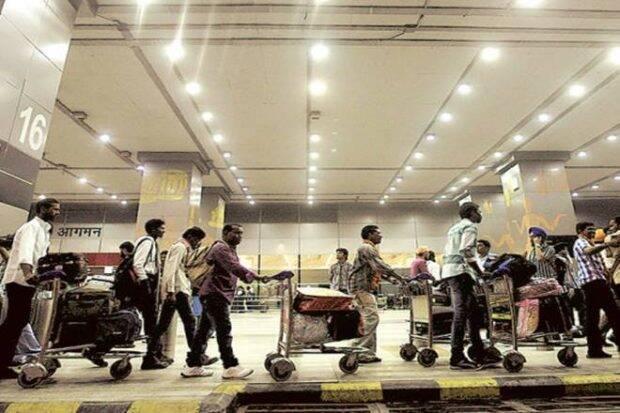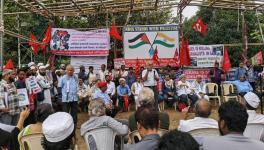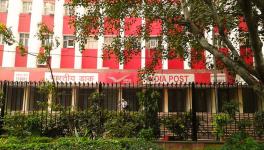How Modi Govt's Policy Change Made Air Travel Expensive in India

Image Courtesy: The Financial Express
In the year 2017, the Government of India changed the way airport tariffs are calculated in India. Airport tariffs are fees that passengers and airlines pay the airport for using its services, which include user development fees (that are a part of air tickets) and aircraft landing charges.
Under the prevailing government policy which was issued in 2011, the government had allowed these tariffs to be fully subsidised by non-aeronautical revenues that an airport earns – car parking fees, rental from duty free shops and restaurants, etc.
But in 2017 the government said that only 30% of such revenues would now cross-subsidise the tariffs. While the 2011 decision was taken to keep air travel affordable, the 2017 decision was based on the need to attract private sector investment into building airport infrastructure. Indeed, in the years since the government has begun handing over public airports to private companies to operate.
How did the 2017 decision affect airport tariffs? And to what extent? This author conducted an analysis of tariff orders issued by the government’s Airports Economic Regulatory Authority of India (AERA). As airports are monopolies, the government retains the power to set tariffs even for airports run by the government’s Airport Authority of India. Tariffs are set through a transparent consultation process and explained in detailed tariff orders than run into more than a hundred pages each.
An analysis of the orders showed that passengers and airlines are now paying a steep price due to the 2017 change. Charges have increased significantly – ranging from 20% at Tiruchirappalli Airport to 54% at the Swami Vivekananda Airport in Raipur, the orders available on the AERA website show. These higher charges are levied directly to passengers via their air tickets, and through charges levied on airlines and air cargo services, which indirectly pass them on to the people.
A steep increase in the price of flying was entirely expected. The Comptroller and Auditor General of India and the Public Accounts Committee of the Indian Parliament have both, in their audits and reports, warned that a 30% subsidy system, known as 'hybrid till system', will burden passengers and cause “undue gains” to airport operating companies. Even in 2017, the government ignored warnings from stakeholders of potential losses to airlines and increased costs of flying and that it contradicts the government’s position otherwise to make air travel more popular and affordable.
The Regulatory Till in India
The accounting policy that determines airport tariffs is known as the ‘regulatory till’. Airport tariffs are pre-determined by regulatory agencies like the AERA; the Till offers guidance on what these tariffs should be in relation to non-aeronautical revenues of the airport.
In 2009, as air travel became popular in India, the government created the AERA to regulate airport business activities and set airport tariffs. In December 2009, AERA issued a white paper on "regulatory philosophy and approach in economic regulations of airports" and sought responses from a variety of stakeholders. This had included a question on which Till system India should follow.
There are two options: Single Till, which allows non-aeronautical revenues to fully cross-subsidise airport tariffs, Dual Till, which allows zero cross-subsidy, and Shared or Hybrid Till, which allows a partial subsidy. Airport operator companies prefer the latter two systems, as it allows them to retain a higher share of non-aeronautical revenues.
The government had then recently privatised the Delhi and Mumbai airports. The PPP agreements had dictated a Hybrid Till with 30% cross-subsidy.
In its response to the white paper, the civil aviation ministry had said that the AERA’s Till mechanism should be unique to each airport based on its contractual obligations, socio-economic objectives of the government, such as in the North-East region, and remote locations, and "other such conditions". "The ultimate objective should be to reduce the burden on the end users (passengers),” it said.
After several stakeholder consultations and research papers, in 2011 the AERA issued an order running into over 70 pages implementing Single Till across the country.
The Authority’s order noted that Single Till was the “most appropriate” mechanism for India because it was in the interest of consumers and could promote affordable aviation. It said that the Planning Commission and the Airports Authority of India had earlier supported the Single Till approach for keeping costs low for passengers, and that the AAI had said that Single Till "serves the interest of State and public" particularly in cases where airport land was provided for free or at low cost by state governments.
The AERA order also gave detailed responses to representations by airport operators and airlines, referred to International Civil Aviation Organisation principles and to a number of research papers and opinions of similar organisations from other countries.
The 2017 Change
In 2016, the Government of India issued a new National Civil Aviation Policy or NCAP. Surprisingly, the policy said that tariffs at all airports would now be calculated on a Hybrid Till basis. It offered no explanation for this shift, other than saying that this would “ensure uniformity and level playing field across various operators.”
“In case the tariff in one particular year or contractual period turns out to be excessive, the airport operator and regulator will explore ways to keep the tariff reasonable, and spread the excess amount over the future,” the policy added.
A few months later, in October 2016, the AERA issued a consultation paper for “aligning certain aspects of AERA’s regulatory approach with the provisions of the NCAP-2016.” This included the shift to a Hybrid Till system. In November it issued a public notice inviting comments from stakeholders.
The meeting proceedings show that stakeholders like the Federation of Indian Airlines (FIA), International Air Travel Association (IATA) and the Air Passengers Association of India (APAI) said the shift to Hybrid Till would increase air travel costs. IATA said there was “lack of compelling evidence” justifying the shift from the 2011 decision, which was arrived at after several rounds of consultations and research. The FIA said that the shift to Hybrid Till would go against the NCAP’s objective of making air travel affordable, and also make it harder for airlines to reduce air fares under the government’s regional aviation scheme ‘Udan’. Some attendees also complained they had too little time to analyse the impact of the shift on their businesses.
But, on 12 January 2017, AERA issued an order formally shifting to the Hybrid Till mechanism for all airports in the country. The order said that despite the 2011 policy, the government had followed Hybrid Till in concession agreements with private airport operators, such as for the upcoming Mopa airport in Goa. The AERA also said that with a 20% growth in air passengers, airports were facing congestion and there was a need was “greater and timely” investments into augmenting airport infrastructure. “A major portion of this investment will have to come from private investors,” it said. Shifting to Hybrid Till “seems to be necessary to attract investments into airports and generate resources for governments,” it said.
Impact on Airport Tariffs
The AERA has determined tariffs for 13 airports since adopting the Hybrid Till system. It includes airports in Amritsar (Punjab), Tiruchirapalli (Tamil Nadu) and Raipur (Chhattisgarh). These airports do not fall under AERA's purview under the AERA Act. But the government requested AERA to determine tariffs for them saying the airports were proposed to be privatised and hence needed a "transparent view to various bidders”.
AERA’s tariff orders determine the tariffs for five years in the future. They include detailed analysis and estimates of every cost and revenue item of an airport for those five years. Numbers for each item are proposed by the Airports Authority of India and often contested by user groups like the Federation of Indian Airlines. The AERA decides the final numbers.
The culmination of this process is the 'yield per passenger' for each year for the airport. ‘Yield per Passenger’ is a composite figure that is then divided into charges levied to passengers and airlines.
The yield is calculated by estimating the costs of running the airport over five years, and then arriving at the desired revenues such that it ensures a fixed profit margin to the airport operator. This is usually set at 14%. From these desired revenues, non-aeronautical revenues are deducted to arrive at the revenue that needs to be earned from airlines and passengers.
Under Hybrid Till, the AERA deducts 30% of the non-aeronautical revenues. In the present analysis, the author replicated the calculations by assuming a deduction of 100% of non-aeronautical revenues. This gives a yield per passenger under a hypothetical Single Till system. Comparing that and the actual yield per passenger shows the extent of difference.
The results show that this increase is steep. In Raipur the yield per passenger is 54% higher under Hybrid Till than if the Single Till mechanism was used. In Amritsar it is 47% higher and in Trichy it is 19% higher. In Jaipur and Thiruvananthapuram airports, large private conglomerate, the yields are 18% and 34% higher, respectively. (In case of successfully privatised airports, the AERA would conduct a fresh tariff determination based on revenue and cost estimates submitted by the private operator. These are yet to be done.).
A further analysis of charges show that landing charges of aircraft have increased even more. Landing charges are calculated based on weight of the aircraft. For an Airbus A320, the most common aircraft used by domestic airlines, landing charges in Raipur have shot up by 64% from earlier. In Thiruvananthapuram airport it has gone up 38%.
Ignoring Warnings from CAG, Stakeholders
Stakeholders like Federation of Indian Airlines and the International Air Travel Association have regularly raised questions about the adoption of the Hybrid Till system in tariff orders.
In one its earliest tariff orders under the new Till system for Jaipur airport, the AERA said that adopting Hybrid Till was necessary to resolve “differential treatment” to airports like Delhi and that it has also caused “some regulatory uncertainty which is not warranted at a time when greater emphasis is being placed on private investments for airport development."
After that, AERA does not seem to offer any explanation in its tariff orders other than repeating a line that it is following its decision from 2017.
Other than increasing the cost of flying, the user groups have also pointed out that since AERA is an independent body under the AERA Act, it was not obliged to adopt the Hybrid Till system just because the government’s aviation policy said so.
Audits by the CAG have also criticised the early experience of the Hybrid Till system. In its 2013 audit report on Delhi’s Indira Gandhi International airport operated by GMR Group the CAG had said that the Hybrid Till gave “unfair advantage to the DIAL [Delhi International Airport Limited] at the cost of the government/passengers.”
One year later, in 2014, the CAG audited the Mumbai airport operated by GVK group and arrived at similar conclusions. It pointed out that non-aeronautical services were “more profitable with low cost of creation and operation […] and high revenues.” The CAG noted that under the hybrid till system “the benefit of low-cost non-aeronautical revenues is largely retained by MIAL [Mumbai International Airport Limited, the operating company], placing a heavier burden on passengers travelling through Mumbai.”
In the audit, the CAG also referred to findings by the Public Accounts Committee of the Parliament in February 2014 on Delhi’s IGI Airport. The Committee, which was then led by Bharatiya Janata Party’s Murli Manohar Joshi, had said that the hybrid till system had “increased the burden on travelling passengers” and deprived the government of revenues through revenue-sharing. The Committee had “urged” the government to “consider this aspect while awarding contracts for other airports under PPP in future.”
The party’s government has instead implemented the system across the country.
(The author, an independent journalist, can be reached at [email protected]. Research for this article was made possible by the Smitu Kothari Fellowship 2020.)
Get the latest reports & analysis with people's perspective on Protests, movements & deep analytical videos, discussions of the current affairs in your Telegram app. Subscribe to NewsClick's Telegram channel & get Real-Time updates on stories, as they get published on our website.
























